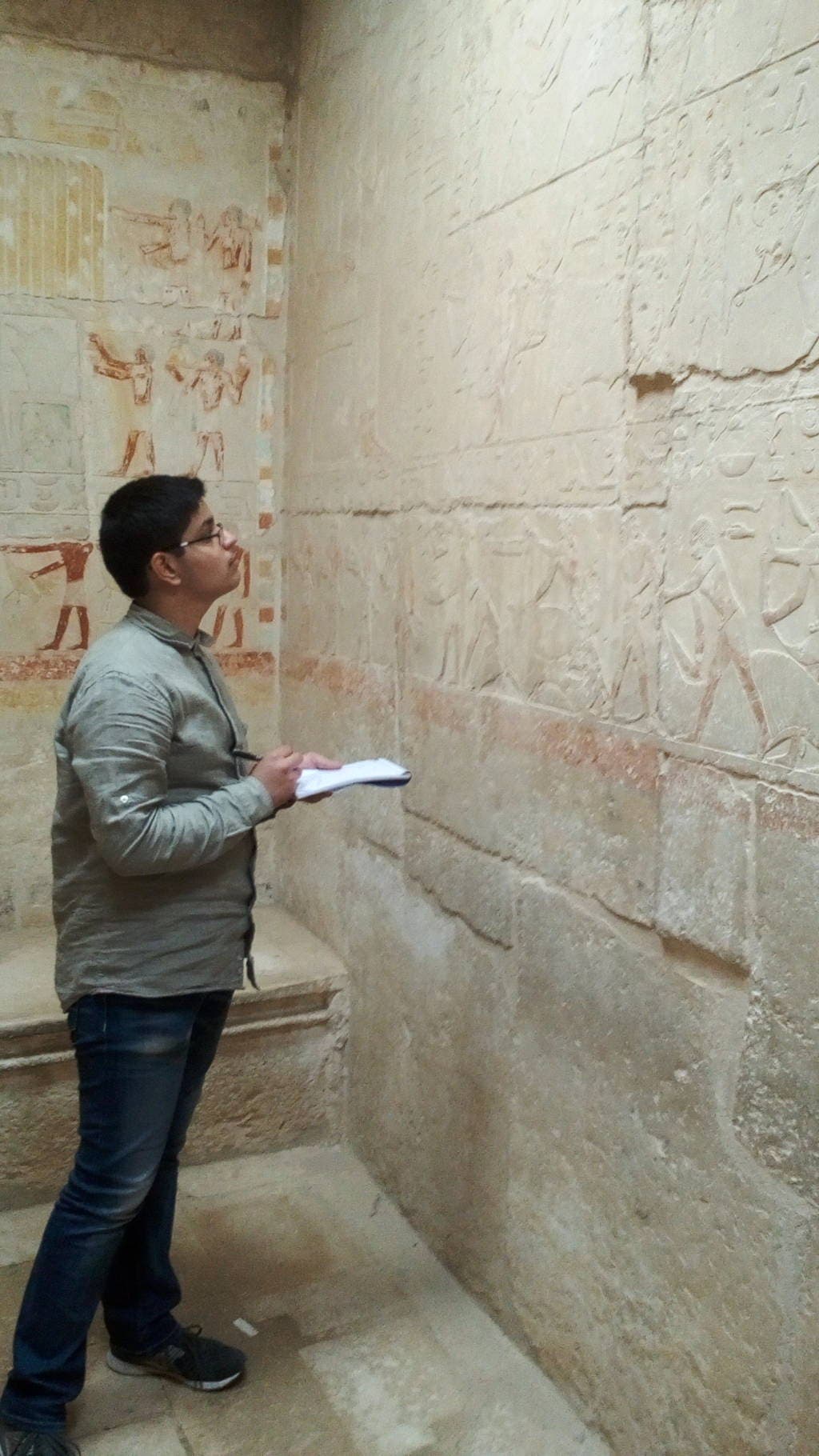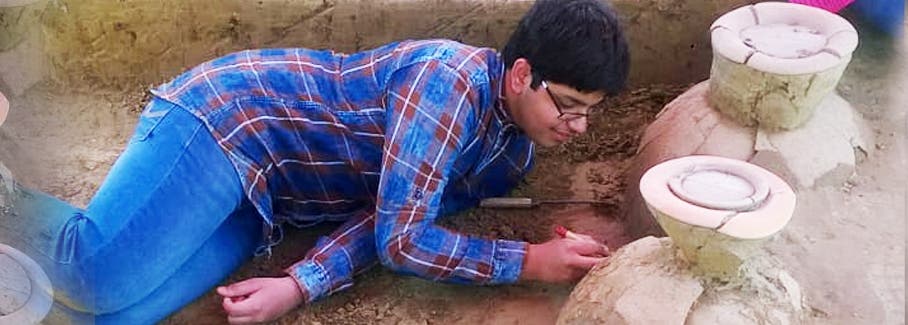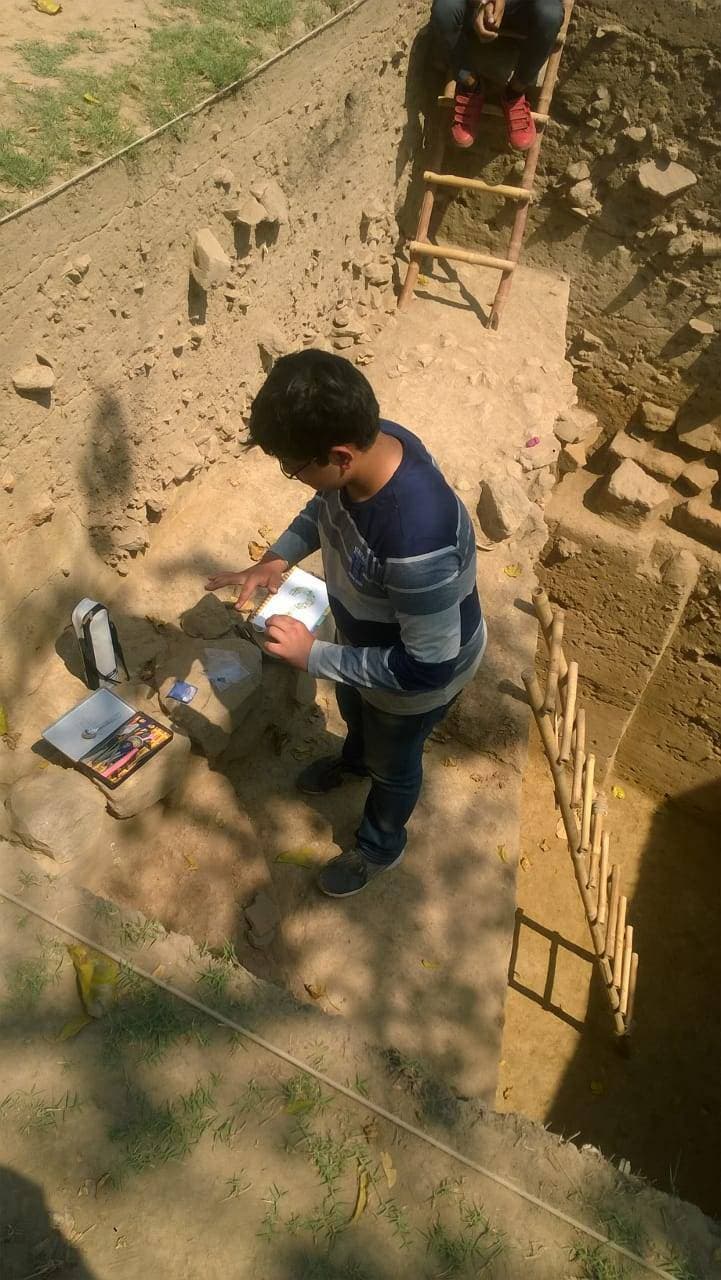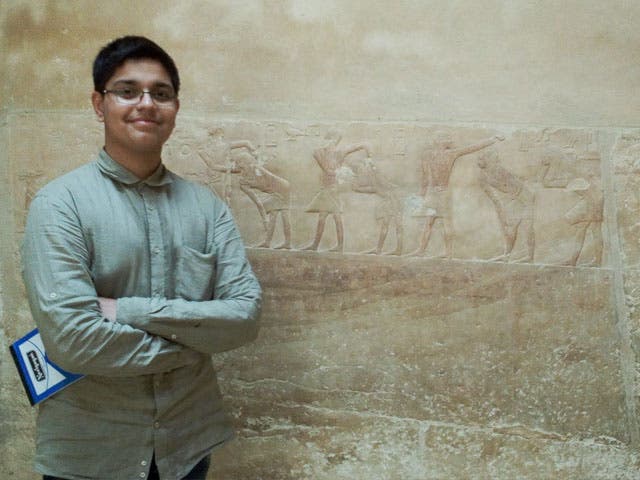He has already been a part of various archaeological excavations and explorations and is currently working on the experimental approach to ancient Egyptian cuisine, particularly bread and ancient Egyptian mummification.
Arsh is working to find more evidence for his research on ‘Egyptian Buddhism’ which seeks to discern the Buddhist proselytism movement of the Indian-Mauryan emperor Ashoka in Egypt around the 3rd century BCE, and its profound effect on both the ancient societies.
Armed with no formal education on archaeology but possessing great knowledge on natural sciences and cultures of different countries the young archaeologist is presently studying in class 12th (A levels) with a combination of Life Sciences and Humanities through the NIOS (National Institute of Open Schooling).
He won a few scholarships from the state cultural department for his proficiency in art while at school. As he progressed in class, he had already started self-learning the hieroglyphs when he was just 10.
His active interest in archaeology and history was becoming more visible. Arsh came in contact with the Archaeological Survey of India (ASI), when he was only in eighth standard.

Arsh is working to find more evidence for his research on ‘Egyptian Buddhism’.
Evidence on Egypt
The ASI, after assessing Arsh’s level of knowledge in archaeology through a panel questioning, allowed Arsh at a tender age of 15, to participate in archaeological excavations that were being undertaken at that time all over the country by the ASI. And the rest is history, as they say.
Responding to Al Arabiya English, the young prodigy said: “After I have discovered a lot of evidence for the topic on Egypt, I am being invited by various archaeological institutions and museums in India and Egypt for delivering lectures/presentations on the same. Most recently, I have also been invited to publish my research papers in some of the most prestigious archaeological journals and reference books.”
“I want to gift something to this world, something that might prove itself to be absolutely useful to this world, either in terms of the understanding of the natural world or some sort of this. And I intend to live my whole life dedicated to knowledge,” he said.
Hailing from Allahabad, Uttar Pradesh and born to Faisal Ali and Fatima Ali, Arsh did his schooling till 10th (O levels) from City Montessori School, Lucknow and subsequently passed the Advanced Placement (AP) exams in world history and European History.
Arsh’s passion for art and archaeology started early and today he spends a great amount of time researching ancient history, visiting digs, presenting papers at seminars, and delivering lectures on history and archaeology.

Arsh has won scholarships from the state cultural department for his proficiency in art while at school.
Convinced of his abilities, the Archaeological Survey of India (ASI), under the Ministry of Culture, the premier organization for the archaeological researches and protection of the cultural heritage of the nation, has been inviting Arsh since 2015 to their programs, seminars, excavations and explorations, a privilege often enjoyed by post-graduate students of archaeology.
Arsh has so far been engaged in seven excavations and explorations since 2015 including the ones at Bijnore, Rakhigarhi, Assam, Sonari, Satdhara, Ranchi and Early Historic site of Purana Qila.
Arsh recently delivered a lecture on “Egyptian Buddhism” as part of the exhibition, India and the World: A History in Nine Stories, at the National Museum in New Delhi.

Arsh came in contact with the Archaeological Survey of India when he was only in eighth standard.
Documentation and research
Arsh’s has several assignments at hand and is meticulously working on Ashokan Buddhist proselytism and its connection with the archaeological and literary sources of India and the Hellenistic world.
He is especially focused on Ptolemaic Egypt; on the experimental approach to the bread-baking techniques of the ancient Egyptians and the experimental approach to ancient Egyptian mummification and on the funerary hieroglyphic inscriptions on the ancient Egyptian coffins and mummies in the various museums all over India.

Arsh recently delivered a lecture on “Egyptian Buddhism”.
Also, he is engaged in the study of the effects of the great Oxygen revolution on the chemical and microbiological composition of the Cambrian stromatolites; comparative skeletal anatomies between reptiles and birds and the evolutionary link between the two on the basis of morphology and fossil record; and the inscriptions discovered in the Brahmaputra river valley in Goalpara district of Assam among others.
Arsh bats for better technology as key tools of investigations and discoveries. He says that aerial photograph has lot of implications in archaeology.
“One of the most important significance of aerial photography in archaeology is that it allows you to have an overview of the whole site and its extent at one glance, whereas ground photography rarely allows you to do so,” he says.
According to him, aerial photography also allows discovery of new sites by means of shadow marks, crop marks, etc. which sometimes goes intractable with some other exploration methods and field methods.
For the teenager who has chosen to straddle different eras and civilizations, digging history deeper is his mission.
Courtesy: english.alarabiya.net
Let the Truth be known. If you read VB and like VB, please be a VB Supporter and Help us deliver the Truth to one and all.
New Delhi (PTI): The Congress on Saturday shared diary entries of Vallabhbhai Patel's daughter from a book to rebut Defence Minister Rajnath Singh's claim that India's first prime minister, Jawaharlal Nehru, wanted to build the Babri masjid using public funds, and demanded that Singh apologise for spreading "falsehoods".
Congress general secretary in charge of communications, Jairam Ramesh, claimed the defence minister was spreading falsehoods to “improve his relationship” with Prime Minister Narendra Modi.
“Here is Maniben's original diary entry in Gujarati on pages 212-213 in the book ‘Samarpit Padchhayo Sardarno’ by CA R S Patel 'Aaresh', published by Sardar Patel Vallabhbhai Patel Memorial Society, 2025,” Ramesh said on X, sharing screenshots of the relevant pages from the book.
“There is a huge difference between what is contained in the original diary entry and what Rajnath Singh ji and his fellow ‘distorians’ are propagating,” Ramesh said.
“The Defence Minister must apologise for the falsehoods he is spreading, simply to improve his relationship with the PM,” he claimed.
The Congress had earlier termed Singh's claim that Nehru wanted to build the Babri masjid using public funds a “lie” and “WhatsApp university story”, and said the defence minister should not walk in Prime Minister Narendra Modi's path.
Addressing a gathering at Sadhli village in Gujarat's Vadodara district last Tuesday, Singh said Nehru wanted to build the Babri masjid using public funds, but Sardar Vallabhbhai Patel didn't allow his plans to succeed.
The BJP had cited a book by Vallabhbhai Patel's daughter to double down on Singh's claims, and said the first prime minister also said he felt "repelled" by some of the temples in south India despite their beauty.
“The source of what Rajnath Singh said is the 'Inside Story of Sardar Patel, Diary of Maniben Patel'," BJP Rajya Sabha MP and national spokesperson Sudhanshu Trivedi had said at a press conference at the party headquarters while responding to media queries on the issue.
Trivedi claimed that on Page 24 of the book, it is written that Nehru also raised the question of the Babri mosque, but Sardar Patel made it clear that the government could not spend any money on building a mosque.





